 |
 |
| Home | Welcome | What's New | Site Map | Glossary | Weather Doctor Amazon Store | Book Store | Accolades | Email Us |
 | |||||||||||||||||||
Dr Isaac M. ClinePart 2
|
|||||||||||||||||||
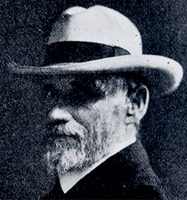 |
| Isaac Cline Photo Courtesy of NOAA/US Dept of Commerce |
As Section Director of the Texas Section of the US Weather Service, Cline's work over the years prior to 1900 included liaison with Mexican Weather Service to establish stations and data exchange along the Gulf Coast, particularly for the detection of severe storms.
Texas agriculturalists expressed their concern over the impact subfreezing temperatures had on their various crops and asked if the Weather Bureau could warn them at least a day in advance of such cold temperatures. Isaac Cline's research convinced him that he could produce such forecasts with an acceptable level of accuracy. Cline sought permission from the Chief of the US Weather Bureau to produce and release such forecasts. (At the time, only Washington was allowed to make and release any forecasts). In response, Moore told Cline: "the scientific staff had looked carefully into the matter and reached the conclusion that it would be impossible for any one to make a forecast of what the temperature would be 24 to 36 hours from the time the forecast was issued with any degree of accuracy."
Confident he could succeed, Cline, on his own initiative, prepared regular forecasts of minimum temperatures during the winter of 1894-95 for the Texas areas of concern and compared them to actual readings. His research showed that minimum temperatures could be forecast with a good degree of accuracy. Chief Moore, on seeing his report of the success, personally gave Cline authorization to issue cold temperature warning forecasts if the public desired them the following winter. In 1895, they would become the first publically released forecasts of what temperature could be expected 24-36 hours in advance. Cline thus became the first forecaster in the United States to release freezing weather warnings to local farmers 24 to 36 hours in advance. According to Cline, these forecasts were immensely successful, particularly to the agricultural community, and soon similar forecasts were issued for other areas of the US.
Cline next turned his attention toward producing timely flood warnings. Because of the extensive irrigation of Texas crops, Cline had access to a good network of precipitation and stream flow observation. With this information, he believed it was possible to warn the public of the likelihood of flooding further downstream.
Cline got the chance to test his warning scheme during the Spring of 1900. Heavy rains in April 1900 brought the danger of flooding to many of Texas' rivers and streams, and Cline kept a watchful eye on the situation. Heavy rains over the Colorado River basin in central Texas on April 7 pushed rivers and streams to dangerous levels. Cline saw that the threat to life and property was imminent when he was informed the dam at Austin had broken. Only Washington could officially issue flood warnings, however. But with the day being late and the following day being Sunday, Cline realized that he would have no time to get Washington's approval and still warn the public.
"But red tape had to be cut, for delay meant the loss of property and human lives." Cline recalled. He took the initiative to warn the public between Austin and the Gulf of Mexico without official permission. As a result, people were able to move to safe ground, and no lives were lost except for two men who drowned when the Austin dam gave way.
Later that month northern and central Texas also suffered unprecedented flooding. The Galveston Weather Office was able to give warnings ten days in advance, and again no lives were lost in the greatest known floods to date on the Brazos River.
Tropical storms were not unknown in the Galveston area. At least 10 times in the 19th Century, a tropical storm had struck the barrier island on which the city stood. In 1875, tidal flooding prompted calls for a beachfront seawall. The idea was revived briefly after an 1886 hurricane erased the town of Indianola, located 150 miles further southwest on the Texas coast, killing 125-150 persons along the Texas coast.
In 1891, Isaac Cline wrote a two-page article in the Galveston News (July 15 edition), on tropical cyclones. In it, he wrote "It would be impossible for any cyclone to create a storm wave which could materially injure the city." And to believe otherwise, he felt, was a grand delusion. Cline based this reasoning on two beliefs. The first believed that if a storm pushed a high surf or a storm tide ahead of it, the waters would simply flow over the city into Galveston Bay and then onto the Texas Prairie, leaving Galveston harmlessly passed over. The second belief held that on the shallow slope of the Gulf coastline, incoming surf would be broken up and thus rendered less dangerous. Hurricanes, he added, did not as a rule strike Texas, and those that did were weak storms.
Nine years later, Cline's beliefs and assurances expressed in that article would be as utterly destroyed as the City of Galveston. Out in the Gulf of Mexico, a storm was gaining fury as it headed toward the Texas coast. It struck the city with full hurricane-force winds and a deadly 15-20-foot storm surge. [Detailed accounts of the The 1900 Galveston Hurricane are given elsewhere on the Weather Doctor site.] When it finally moved inland on September 9th, Galveston lay in ruins, and over 6,000 residents were dead or missing.
A few weeks later, Cline submitted a Special Report on The Galveston Hurricane of September 8, 1900 which was published in Monthly Weather Review for September 1900. Cline described the approach and passage of the storm in the following accounts, extracted from report.
"Storm warnings were timely and received a wide distribution not only in Galveston but throughout the coast region. Warning messages were received from the Central Office at Washington on September 4, 5, 6, 7, and 8....The usual signs which herald the approach of hurricanes were not present in this case....A heavy swell from the southeast made its appearance in the Gulf of Mexico during the afternoon of the 7th. The swell continued during the night without diminishing, and the tide rose to an unusual height when it is considered that the wind was from the north and northwest...."
"A storm velocity was not attained until about 1 p.m. [September 8] after which the wind increased steadily and reached a hurricane velocity about 5 p.m. The greatest velocity for five minutes was 84 miles per hour at 6:15 p.m. With two minutes at the rate of 100 miles per hour. The anemometer blew away at this time, and it is estimated that prior to 8 p.m. the wind attained a velocity of at least 120 miles per hour....Soon after 3 p.m. conditions became so threatening that it was deemed essential that a special report be sent at once to Washington. Mr. J. L. Cline, Observer, took the instrumental readings while I drove first to the bay and then to the Gulf, and finding that half the streets of the city were under water added the following to the special observation at 3:30 p.m.: 'Gulf rising, water covers streets of about half of city'."
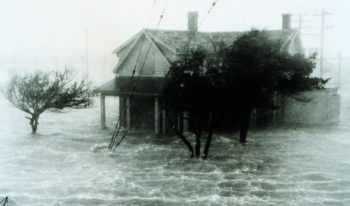 |
Photo Courtesy of NOAA/US Dept of Commerce |
Cline left the office to have lunch at his home which stood three blocks from the now seething waters of the Gulf.
"I reached home and found the water around my residence waist deep. I at once went to work assisting people, who were not securely located, into my residence, until forty or fifty persons were housed therein. About 6:30 p.m. Mr. J. L. Cline, who had left Mr. Blagden at the office to look after the instruments, reached my residence, where he found the water neck deep. He informed me that the barometer had fallen below 29.00 inches; that no further messages could be gotten off on account of all wires being down, and that he had advised everyone he could see to go to the center of the city; also, that he thought we had better make an attempt in that direction. At this time, however, the roofs of houses and timbers were flying through the streets as though they were paper, and it appeared suicidal to attempt a journey through the flying timbers. Many people were killed by flying timbers about this time while endeavoring to escape to town."
"The water rose at a steady rate from 3 p.m. until about 7:30 p.m., when there was a sudden rise of about four feet in as many seconds. I was standing at my front door, which was partly open, watching the water, which was flowing with great rapidity from east to west. The water at this time was about eight inches deep in my residence, and the sudden rise of 4 feet brought it above my waist before I could change my position. The water had now reached a stage 10 feet above the ground at Rosenberg Avenue (Twenty-fifth street) and Q street, where my residence stood. The ground was 5.2 feet elevation, which made the tide 15.2 feet. The tide rose the next hour, between 7:30 and 8:30 p.m., nearly five feet additional, making a total tide in that locality of about twenty feet....By 8 p.m. a number of houses had drifted up and lodged to the east and southeast of my residence, and these with the force of the waves acted as a battering ram against which it was impossible for any building to stand for any length of time, and at 8:30 p.m. my residence went down with about fifty persons who had sought it for safety, and all but eighteen were hurled into eternity. Among the lost was my wife, who never rose above the water after the wreck of the building. I was nearly drowned and became unconscious, but recovered through being crushed by timbers and found myself clinging to my youngest child, who had gone down with myself and wife. Mr. J. L. Cline joined me five minutes later with my other two children, and with them and a woman and child we picked up from the raging waters, we drifted for three hours, landing 300 yards from where we started. There were two hours that we did not see a house nor any person, and from the swell we inferred that we were drifting to sea, which, in view of the northeast wind then blowing, was more than probable."
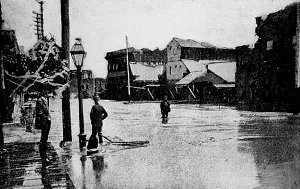 |
Photo Courtesy of NOAA/US Dept of Commerce |
Cline summarized the storm's impact thus:
"Sunday, September 9, 1900, revealed one of the most horrible sights that ever a civilized people looked upon. About three thousand homes, nearly half the residence portion of Galveston, had been completely swept out of existence, and probably more than six thousand persons had passed from life to death during that dreadful night. The correct number of those who perished will probably never be known, for many entire families are missing. Where 20,000 people lived on the 8th not a house remained on the 9th, and who occupied the houses may, in many instances, never be known....All goods and supplies not over eight feet above floor were badly injured, and much was totally lost. The damage to buildings, personal, and other property in Galveston County is estimated at above thirty million dollars. The insurance inspector for Galveston states that there were 2,636 residences located prior to the hurricane in the area of total destruction, and he estimates 1,000 houses totally destroyed in other portions of the city, making a total of 3,636 houses totally destroyed. The value of these buildings alone is estimated at $5,500,000."
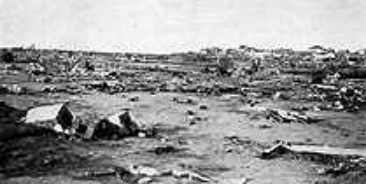 |
Photo Courtesy of NOAA/US Dept of Commerce |
Cline, contrary to his views given in the 1891 article, now believed that the city needed a sea wall for protection:
"I believe that a sea wall, which would have broken the swells, would have saved much loss of both life and property. I base this view upon observations which I have made in the extreme northeastern portion of the city, which is practically protected by the south jetty; this part of the city did not suffer more than half the damage that other similarly located districts, without protection, sustained."
He further commented in his autobiography: "This being my first experience in a tropical cyclone I did not foresee the magnitude of the damage which it would do."
In his book Isaac's Storm author Erik Larson describes Cline as a prideful and arrogant man whose overestimation of his own scientific skills and his inability to predict the hurricane caused the deaths of more than 6,000 Galvestonians. He believes that the accounts presented in Cline's autobiography of the storm are an attempt to hide the shameful truth.
But others do not agree, including Ron Stagno, a retired weather service meteorologist, who often portrays Cline in dramatic monologues to local schools and civic groups. He believes that instead of blaming Cline, he should be credited with saving at least as many as perished. Stagno points out that Cline hoisted hurricane warning flags without permission from Washington, an act that could have cost him his position.
If any blame must be placed, perhaps the strong bureaucracy and high-mindedness of the Weather Bureau should take the brunt of it. But remember that communications and observing systems were in their infancy as was the science of tropical storm forecasting. Even if hurricane warnings had been posted further in advance, it is likely that most longtime residents who had previously weathered storms in Galveston would not have fled to the mainland. Instead they sought shelter in what they believed were their safe homes. (Even today, many coastal residents feel the same when a hurricane approaches.)
We can only take the reactions from Cline's boss Professor Willis L. Moore and others as to how Cline's actions at the time were viewed. And these were in most accounts favourable.
As Chief of the Weather Bureau, Moore would write to Cline on September 28th:
"I desire to most highly commend you and your two assistants, Messrs. Joseph L. Cline and John D. Blagden, for your heroic devotion to duty on the occasion of the hurricane that devastated Galveston on September 8, 1900. The record shows that you were all alert and vigilant from the time the first notice of the storm was received, making frequent observations of the instruments and the weather conditions and disseminating warnings, and that under great personal peril you remained at your posts as long as your services were of any value, performing all duties efficiently and intelligently;...Through the efficient service of yourself and your assistants in the dissemination of warnings, thousands of people were enabled to move from the lower to the higher and secure portions of the city and were thus saved....Your conduct in this terrible crisis furnishes an example of courage and fidelity to duty that every employee of the Bureau should be proud to emulate."
Writing on the subject in 1927, years after his retirement from the Bureau, Moore again praised the work of Cline:
"The press dispatches at the time of the Galveston storm stated that Dr. Isaac M. Cline, the head observer of the Weather Bureau there, was one of the heroic spirits of that awful Saturday; that in addition to warning the people by telegraph and telephone, he worked personally among those on the beach..."
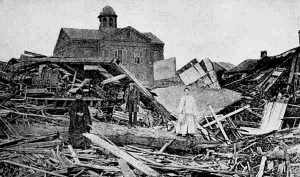 |
Photo Courtesy of NOAA/US Dept of Commerce |
Both Isaac and Joseph returned to their work at the weather office on the 9th despite their injuries and Isaac's emotional state of having lost his pregnant wife and being left to care for three daughters. Both finally gave in to their injuries and were hospitalized. The daily journal in the Galveston Weather Office for September 10 notes: "I.M. Cline absent today on account of injuries received in the storm. J.L. Cline left in charge. Unable to do much."
Cline lost all but his daughters in the tragedy. Although he still owed money on his house and was advised to file for bankruptcy, Cline pridefully refused and found private money to take his debt. Two years later, the lawyer for the group approached Cline and informed him that: "the people who loaned you the money, will, on account of the great service you rendered to the people of Galveston during the storm, cancel the claim against you..."
Part 1: Dr Isaac M. Cline: The Early Years
Part 3: Dr Isaac M. Cline: New Orleans: Watching A River
For more information on Issac Cline and the 1900 Galveston Hurricane, see these articles:
The Weather Doctor--Weather Almanac, September 2000: Wasn't That A Mighty Storm?
The Weather Doctor--Weather Events: The 1900 Galveston Hurricane
The full text of Isaac Cline's storm report appeared in Monthly Weather Review (September 1900): Special Report on The Galveston Hurricane of September 8, 1900.
Reminescence of Cline on the early years of the US national weather service can be found at Personal View of Issac M. Cline.
Finally, The Weather Notebook has devoted three programs to the event: |
To Purchase Notecard, |
Now Available! Order Today! | |
 |
 |
NEW! Now |
The BC Weather Book: |


